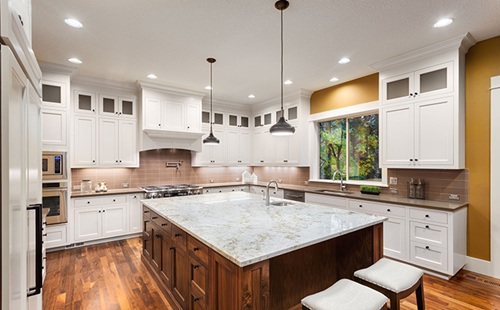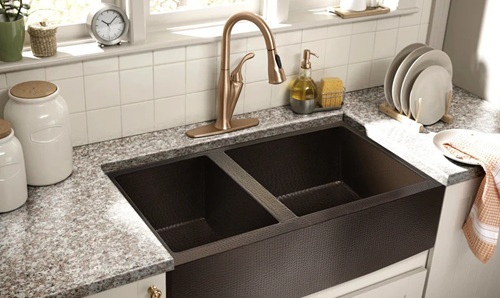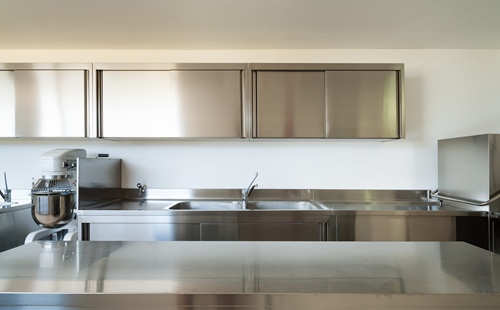When it comes to kitchen design, the flooring you choose has a major impact on the space’s look, comfort, and durability. One of the most debated choices is hardwood flooring—celebrated for its natural beauty and warmth but also questioned for its suitability in moisture-prone areas like the kitchen.
Let’s take a comprehensive look at the pros and cons of hardwood flooring in the kitchen, so you can decide if it’s the right fit for your lifestyle and aesthetic goals.

🪵 What Is Hardwood Flooring?
Hardwood flooring is made from natural timber cut into planks. There are two primary types used in kitchens:
- Solid Hardwood: Made from a single piece of wood, can be sanded and refinished multiple times.
- Engineered Hardwood: Made with a veneer of hardwood on top of plywood layers, offering more stability in humid environments.
Hardwoods like oak, maple, hickory, and walnut are common in kitchen applications for their strength and aesthetic variety.
✅ Pros of Hardwood Flooring in the Kitchen
1. Timeless Beauty and Natural Appeal
Hardwood floors offer unmatched visual warmth and charm. Their rich grains, earthy tones, and organic textures elevate the look of any kitchen—whether it’s farmhouse, modern, rustic, or transitional.
Design Tip: Lighter woods like ash or maple brighten smaller kitchens, while darker woods like walnut add dramatic contrast.
2. Comfort Underfoot
Compared to hard surfaces like tile or stone, wood is softer and warmer to stand on. This is a major advantage if you spend long periods cooking or cleaning. It also helps cushion dropped dishes, potentially saving your favorite glassware.
3. Increases Home Value
Hardwood flooring is a highly desirable feature for homebuyers. A kitchen with hardwood floors can increase resale value and make your home more appealing on the market.
Fact Check: According to the National Association of Realtors, buyers are often willing to pay more for homes with hardwood flooring.
4. Versatility Across Spaces
Using the same hardwood flooring in the kitchen and adjoining living or dining areas creates a seamless visual flow, especially in open-plan homes. This continuity makes spaces feel larger and more cohesive.
5. Long Lifespan with Proper Care
High-quality hardwood floors can last 30–100 years, especially solid wood that can be refinished multiple times. Even engineered wood can last 20–40 years with the right maintenance.
❌ Cons of Hardwood Flooring in the Kitchen
1. Sensitive to Moisture and Water Damage
One of the biggest drawbacks of wood flooring in the kitchen is its vulnerability to moisture. Spills, splashes, or leaks can cause wood to swell, warp, or stain if not cleaned quickly.
Pro Tip: Use water-resistant sealants and mats in high-risk areas like under the sink and dishwasher.
2. Prone to Scratches and Dents
Kitchens are high-traffic areas, and wood floors can be scratched by chairs, pet claws, fallen utensils, or dragging appliances. Harder woods (like hickory or oak) resist dents better, but no wood is completely scratch-proof.
3. Requires Regular Maintenance
To keep hardwood floors looking good, you’ll need to sweep regularly, use wood-safe cleaners, and occasionally reseal or refinish the surface. Spills must be wiped promptly to avoid staining or water penetration.
Maintenance Tip: Avoid steam mops or soaking the floor while cleaning—excess water is the enemy of wood.
4. Costly Installation and Repairs
Hardwood is a premium flooring option. The initial cost and installation fees are high, and repairs (like replacing warped planks or refinishing worn sections) can be expensive.
Estimated Cost (USA):
- Solid Hardwood: $8–$15 per sq. ft. (installed)
- Engineered Hardwood: $6–$12 per sq. ft. (installed)
Estimated Cost (India):
- Solid Hardwood: ₹400–₹1,000 per sq. ft.
- Engineered Wood: ₹250–₹600 per sq. ft.
5. Not Ideal for Rough or Messy Use
In households with small children, pets, or heavy kitchen use, the floor is more likely to face damage. Repeated exposure to moisture or rough use can degrade hardwood faster than more durable options like vinyl or tile.
⚖️ Comparison: Hardwood vs Other Kitchen Flooring Options
| Feature | Hardwood | Tile | Vinyl Plank | Laminate |
| Aesthetic Appeal | Excellent | Good | Good | Moderate |
| Comfort Underfoot | High | Low | High | Moderate |
| Water Resistance | Low | Excellent | High | Moderate |
| Scratch Resistance | Moderate | High | Moderate | Moderate |
| Maintenance Needs | Moderate–High | Low | Low | Low |
| Lifespan | Very High | Very High | Moderate | Moderate |
| Refinishing Options | Yes (solid wood) | No | No | No |
| Cost Range (USA) | High | Moderate–High | Low–Moderate | Low |
🛠️ Tips for Using Hardwood Floors in Kitchens
- Seal the Surface: Use a strong, water-resistant finish like polyurethane to protect the wood from spills and moisture.
- Use Rugs or Mats: Place washable mats near the sink, stove, and dishwasher.
- Clean Smart: Avoid soaking mops; use a lightly damp cloth or wood-specific cleaner.
- Add Furniture Pads: Attach felt pads to the bottom of chairs and tables to avoid scratches.
- Refinish When Needed: Sand and refinish the floor every few years to maintain shine and durability.
🏁 Is Hardwood Flooring Right for Your Kitchen?
✅ Choose Hardwood If:
- You want a natural, elegant look that adds warmth to your kitchen.
- Your kitchen is part of an open-plan layout, and you want cohesive flooring.
- You’re prepared to care for spills and conduct routine maintenance.
- You’re looking for a long-term, value-enhancing investment.
❌ Avoid Hardwood If:
- Your kitchen is high-moisture, frequently messy, or used heavily.
- You prefer low-maintenance and waterproof flooring options.
- You have young children or pets who can cause frequent spills or scratches.
- You’re working on a tight renovation budget.
🧾 Final Verdict
Hardwood flooring in the kitchen offers unmatched natural beauty, comfort, and home value. It’s an ideal choice for homeowners who appreciate timeless aesthetics and are committed to regular care. While not the most practical option for everyone—especially in high-moisture or high-impact environments—it can be a rewarding investment if treated well.
If you’re someone who prioritizes visual appeal and is willing to maintain the surface, hardwood can give your kitchen both charm and longevity. But for households that need rugged, waterproof, and maintenance-free flooring, alternatives like tile, luxury vinyl, or laminate may be a better fit.

